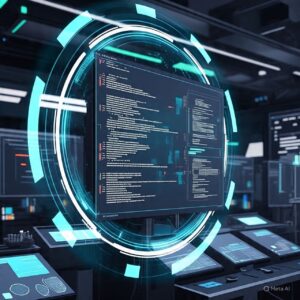As technology continues to evolve, the intersection of artificial intelligence (AI) and cybersecurity is becoming one of the most significant developments of our time. In 2025 and beyond, AI is expected to play a dual role—serving as both a defender and a potential threat to cyber infrastructures. This rapid transformation raises a crucial question: What’s next for cybersecurity in the age of AI?
In this blog, we explore the emerging cybersecurity trends for 2025, examine how AI is reshaping cyber defense, and outline what businesses and individuals must do to stay ahead of increasingly sophisticated digital threats.
Understanding the AI-Cybersecurity Nexus
To understand the future, we must first grasp how AI integrates with cybersecurity today. At its core, AI in cybersecurity is about automating threat detection, analyzing patterns, and enabling faster incident response. Traditional systems often rely on signature-based detection, which can be easily bypassed by new, unknown threats. However, AI-powered systems, particularly those based on machine learning and behavioral analytics, can identify anomalies and predict threats before they happen.
For instance, AI can:
-
Monitor network traffic in real time
-
Identify suspicious user behavior
-
Automate responses to cyber incidents
-
Detect zero-day vulnerabilities before they’re exploited
In short, AI adds speed, accuracy, and scalability to the cybersecurity equation.
The Double-Edged Sword: AI-Driven Cyber Threats
While AI strengthens defense, it also arms attackers with powerful new tools. Cybercriminals are leveraging AI to develop advanced malware, automate phishing schemes, and conduct social engineering attacks on a massive scale.
Here are some concerning developments:
-
AI-generated phishing emails are becoming harder to detect, mimicking writing styles and even emotional tones.
-
Deepfake technology enables hackers to impersonate CEOs and public figures for fraudulent transactions or data breaches.
-
AI-enhanced malware can learn from the environment it infects, adapting to avoid detection by conventional antivirus systems.
These examples make one thing clear: AI in cybercrime is a reality, not a possibility. As attackers become more creative, defenders must evolve faster.
Top Cybersecurity Trends to Watch in 2025
Looking forward, several cybersecurity trends in 2025 are expected to reshape how organizations protect themselves:
1. Zero Trust Architecture
With traditional perimeter defenses no longer sufficient, many organizations are moving toward a Zero Trust security model. This means every access request—whether from inside or outside the network—is treated as potentially hostile and must be verified. AI plays a critical role in continuously authenticating users and monitoring access behavior.
2. AI-Augmented Security Operations
Rather than replacing human analysts, AI will augment cybersecurity professionals. It will handle routine tasks such as log analysis, anomaly detection, and initial threat triage—freeing up experts to focus on strategic decisions and incident response.
3. Cloud and Edge Security
With the growth of remote work and distributed networks, cloud-based cybersecurity solutions are more important than ever. AI-driven tools are being used to secure data across cloud environments, while edge computing security will require specialized protocols to protect devices and micro data centers.
4. IoT and Smart Device Protection
The rapid expansion of the Internet of Things (IoT) poses new cybersecurity challenges. Billions of connected devices—from smart home systems to industrial sensors—create a vast attack surface. AI-based IoT security systems can help manage these endpoints, detect vulnerabilities, and stop threats before they spread.
5. Regulatory Compliance and AI Ethics
As governments tighten data privacy laws, organizations must align with evolving cybersecurity regulations like GDPR, India’s Digital Personal Data Protection Act, and AI governance frameworks. Ensuring ethical and responsible use of AI will be crucial for maintaining trust and compliance.
Challenges in Implementing AI-Driven Cybersecurity
While AI brings many benefits, it’s not without challenges. Several issues can undermine the effectiveness of AI in cybersecurity:
-
Bias in AI algorithms can lead to missed threats or false positives.
-
Over-reliance on automation might delay human intervention during nuanced attacks.
-
Adversarial attacks—where attackers manipulate AI models—can cause systems to malfunction or overlook critical threats.
-
Data privacy concerns arise when training AI models on sensitive information.
Therefore, organizations must strike a balance between automation and human oversight, ensuring AI systems are transparent, accountable, and regularly updated.
Real-World Applications of AI in Cybersecurity
Leading companies and cybersecurity firms are already leveraging AI in practical ways. Some notable examples include:
-
IBM’s QRadar Suite uses AI to correlate security events and prioritize threats based on risk.
-
Darktrace, an AI cybersecurity firm, employs machine learning to detect threats in real time and respond autonomously.
-
Microsoft Defender integrates AI to offer endpoint protection across millions of devices worldwide.
These solutions showcase how AI is transforming cybersecurity from a reactive process to a proactive strategy.
How Businesses Can Prepare for the AI-Driven Future
To navigate this rapidly changing landscape, businesses must adopt a multi-layered approach. Here are some practical steps:
1. Invest in AI-Integrated Security Tools
Choose platforms that incorporate AI and machine learning for threat detection, network monitoring, and automated responses.
2. Educate Employees
Human error remains a leading cause of data breaches. Offer training on cyber hygiene, AI awareness, and identifying social engineering tactics.
3. Build a Cyber-Resilient Culture
Make cybersecurity a shared responsibility across all departments. Encourage regular audits, incident response drills, and data protection best practices.
4. Partner with Trusted Cybersecurity Providers
Collaborate with vendors who are leaders in AI-driven security, and ensure they comply with global regulations and offer real-time support.
5. Stay Updated with Compliance Requirements
Regularly monitor changes in cybersecurity laws and AI ethics frameworks, and ensure internal systems and practices remain aligned.
Final Thoughts: The Road Ahead
The future of cybersecurity in the age of AI is both exciting and daunting. While AI offers unprecedented opportunities to strengthen defense, it also presents new risks that demand strategic foresight. As the digital battlefield evolves, organizations must remain agile, informed, and proactive.
By embracing AI responsibly and ethically, we can transform cybersecurity from a barrier into a powerful enabler of innovation, trust, and digital freedom.


